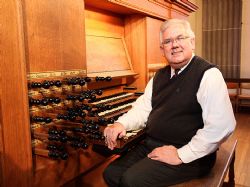|
Recital
ELEGANT VOCAL MASTERY AT ROSES SIGNATURE RECITAL
by Pamela Hicks Gailey
Sunday, February 25, 2024
Recital
DEMANDING SCHUMANN WORK IN MUSIC AT OAKMONT RECITAL
by Terry McNeill
Thursday, November 9, 2023
Recital
RARE RAVEL IN MENDO FESTIVAL'S PRESTON HALL
by Terry McNeill
Thursday, July 20, 2023
Recital
FRENCH FLAVOR IN RARE FOUR-HAND RECITAL
by Judy Walker
Sunday, January 15, 2023
Recital
ASSERTIVE PIANISM IN YAKUSHEV'S OCCIDENTAL RECITAL
by Terry McNeill
Sunday, November 13, 2022
Recital
HEROIC LIM PERFORMANCE AT STEINWAY SOCIETY RECITAL
by Abby Wasserman
Sunday, September 18, 2022
Recital
AGGRESSIVE PIANISM IN MYER'S MENDO FESTIVAL RECITAL
by Terry McNeill
Thursday, July 14, 2022
Recital
UNIQUE ELEGANCE IN GALBRAITH GUITAR RECITAL
by Gary Digman
Friday, April 29, 2022
Recital
ALLURING GLASS WORKS IN WEILL RECITAL
by Terry McNeill
Friday, March 25, 2022
Recital
FORGOTTEN BACH SHINES IN YARDEN'S OAKMONT RECITAL
by Terry McNeill
Thursday, March 10, 2022
|
 |
 Organist James David Christie |
HERE COMES THE ORGAN!
by James Harrod
Saturday, August 23, 2014
The rich sounds of Dutch Renaissance organ flutes, reeds, and mixtures sounded in Sonoma County August 23 when James David Christie inaugurated the new Schroeder Hall pipe organ installation at Sonoma State University. Under the performer’s experienced and sensitive touch, the Brombaugh Opus 9 mechanical action instrument spoke with an outstanding clear and authentic Baroque organ voice.
Without fail throughout the afternoon’s program Mr. Christie’s clear, articulated touch in both the manuals and pedals demonstrated a mastery of accuracy, clarity, and uncompromised precision essential for the correctly desired execution of Baroque music.
Although the Schroeder organ is not a large instrument, the voice of each rank of pipes is so distinctive that large combinations of stops are not necessary to produce the desired artistic effects. Mr. Christie chose a program that demonstrated the beauty of each stop of the organ alone and in dialogue with others. This does not require the massive sound typically heard in familiar organ music.
The artist chose six organ works, both familiar and rare, from the Baroque repertory of northern Europe, 1562 to 1750. These were: Praeludium in C Major, Georg Böhm (1661 - 1733); Camphuysen manuscript (Anon. Dutch 16th century) Daphne (3 variations); Ricercar, Sweelinck (1562 - 1621); Praeludium in G Minor (BuxWV 163) Buxtehude (ca 1637 - 1707); Ciaconna in B-flat Major, Johann Bernhard Bach (1676 - 1749); and Toccata and Fugue in D Minor (BWV 565), Bach (1685 - 1750).
The Böhm Praeludium got everyone’s attention with the opening pedal and manual ascending and descending cadenzas, played on organ plenum and reeds, followed by a breathtaking toccata and fugue of leaping octaves in both hands and feet. Each note in this complex composition could be distinctly heard, even though the full organ was utilized in its execution.
The anonymous Camphuysen manuscript, one of the oldest surviving organ music pieces set to a written score, displayed the simple beauty of tune played with only one and two stops, typical of Renaissance secular music. Sweelinck’s Ricercar, a composition of recurring motifs in four singing voices, evolved under the organist’s hands into a fugue, in which the marching motives built in intensity as organ stops were added.
Buxtehude’s richly ornamented contrapuntal Praeludium consists of four toccata movements enclosing three fugues, each of which end without a resolving chord before moving ahead on into the next toccata. This was played with perfectly even cadence, rhythm, and appropriately rich registrations. The very delicate Ciaconna, similar to a passacaglia, is a sweet three quarter time gigue, played on each of the beautifully voiced flute stops of the organ, solo and in combination. Mr. Christie’s careful choice of registration provided freshness to each repetition of the motif.
Bach’s familiar yet always welcome Toccata and Fugue in D minor closed a majestic and instructive program. It was first published in 1833 through Mendelssohn’s efforts. It became quickly popular and is one of the most famous works in the repertoire, although now there is scholarly dispute as to Bach‘s authorship. Once again the dense composition of the work did not obscure the clear and precise articulated touch necessary for the experience of the composer’s intention.
It is important that we note the special characteristics of the Schroeder organ, especially in relation to the authenticity of the program played. The instrument was largely hand built by John Brombaugh in the exact manner of the Dutch and north German baroque instruments still existing today. The organ has a mechanical, or "tracker" key action rather than an electric key action. Only the blower supplying the wind is electric. Tracker-action mechanics allow the organist to “feel” whenever each pipe opens and speaks. The touch of the keys is very sensitive and requires virtuoso skill to effectively perform the music. That skill was everywhere evident in the magical performance by Mr. Christie.
|
